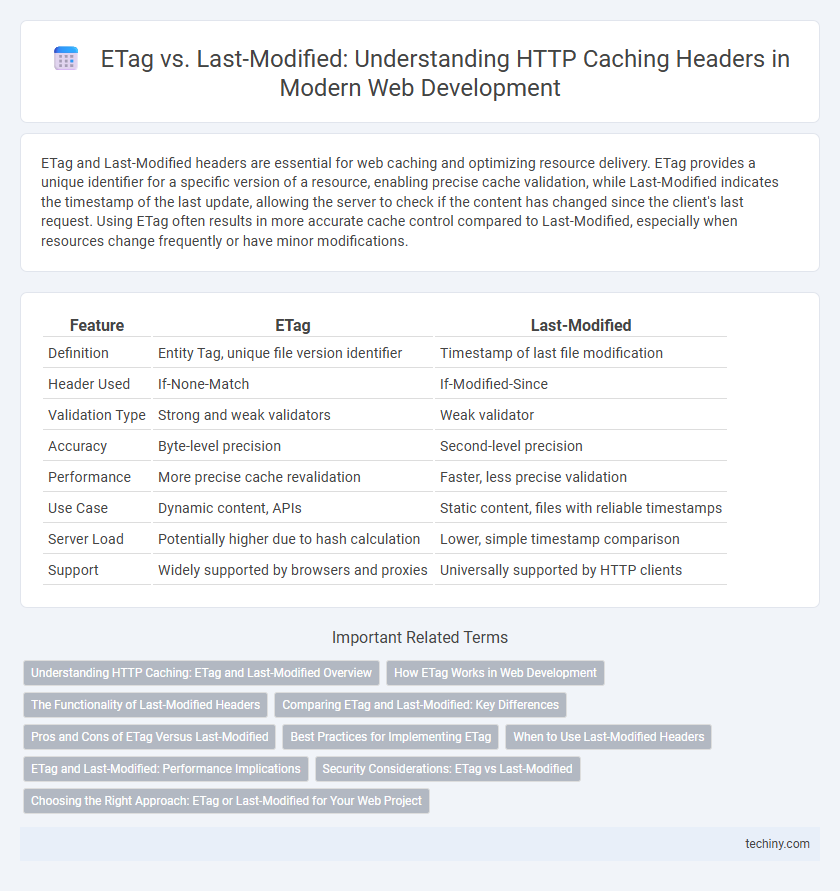ETag and Last-Modified headers are essential for web caching and optimizing resource delivery. ETag provides a unique identifier for a specific version of a resource, enabling precise cache validation, while Last-Modified indicates the timestamp of the last update, allowing the server to check if the content has changed since the client's last request. Using ETag often results in more accurate cache control compared to Last-Modified, especially when resources change frequently or have minor modifications.
Table of Comparison
| Feature | ETag | Last-Modified |
|---|---|---|
| Definition | Entity Tag, unique file version identifier | Timestamp of last file modification |
| Header Used | If-None-Match | If-Modified-Since |
| Validation Type | Strong and weak validators | Weak validator |
| Accuracy | Byte-level precision | Second-level precision |
| Performance | More precise cache revalidation | Faster, less precise validation |
| Use Case | Dynamic content, APIs | Static content, files with reliable timestamps |
| Server Load | Potentially higher due to hash calculation | Lower, simple timestamp comparison |
| Support | Widely supported by browsers and proxies | Universally supported by HTTP clients |
Understanding HTTP Caching: ETag and Last-Modified Overview
ETag and Last-Modified are key HTTP headers used for caching to improve web performance by reducing unnecessary data transfers. ETag provides a unique identifier for a specific version of a resource, enabling precise cache validation, while Last-Modified indicates the timestamp of the last change to the resource, supporting basic freshness checks. Efficient use of ETag and Last-Modified headers allows browsers and servers to determine if cached content is still valid, optimizing bandwidth and load times.
How ETag Works in Web Development
ETag (Entity Tag) generates a unique identifier for a specific version of a web resource by hashing its content, enabling precise cache validation. When a client requests a resource, the server compares the ETag value with the client's cached version to determine if the resource has changed, reducing unnecessary data transfers. This mechanism enhances web performance by minimizing bandwidth usage and improving load times through efficient conditional requests.
The Functionality of Last-Modified Headers
Last-Modified headers enable efficient cache validation by indicating the timestamp of the resource's last change, allowing browsers to send conditional requests with If-Modified-Since headers. When the server compares this timestamp with the resource's current state, it responds with a 304 Not Modified status if the content hasn't changed, reducing bandwidth usage and load times. This mechanism is simpler but less precise than ETags, which provide unique identifiers for content versions.
Comparing ETag and Last-Modified: Key Differences
ETag and Last-Modified headers serve as cache validators in web development, with ETag providing a unique identifier based on resource content changes, while Last-Modified relies on timestamps indicating the last update. ETag offers precise change detection by matching hash values, making it ideal for dynamic content, whereas Last-Modified is simpler but less reliable due to clock skew and lack of granularity. Choosing between ETag and Last-Modified depends on accuracy requirements and server resource constraints in HTTP caching strategies.
Pros and Cons of ETag Versus Last-Modified
ETag provides a more precise validation mechanism by generating a unique identifier based on resource content changes, enabling effective cache control and preventing unnecessary data transfer. Last-Modified relies on timestamps, which can be less accurate due to clock skew or granularity issues, potentially causing stale content to be served. However, ETag headers can increase response size and add processing overhead on servers, whereas Last-Modified is lighter and simpler to implement, making it suitable for scenarios with minimal resource change frequency.
Best Practices for Implementing ETag
ETags provide precise cache validation by uniquely identifying resource versions, improving efficiency over Last-Modified timestamps that rely on coarse date comparisons. Best practices for implementing ETags include generating strong validators based on content hashes or version identifiers to ensure accurate cache validation and avoiding weak validators that can lead to stale content delivery. Properly configured ETags reduce bandwidth usage and server load while enhancing user experience through faster page loads.
When to Use Last-Modified Headers
Last-Modified headers are ideal for resources that change infrequently and have predictable update times, such as static images or archived pages. They enable efficient client-side caching by allowing browsers to validate cached content based on the resource's timestamp, reducing unnecessary data transfer. Use Last-Modified headers when server processing overhead needs to be minimized and when precise content versioning is less critical than update recency.
ETag and Last-Modified: Performance Implications
ETag provides a more precise cache validation by using a unique identifier representing the specific version of a resource, minimizing unnecessary data transfers and improving performance in dynamic content scenarios. Last-Modified relies on timestamp comparisons that can be less reliable due to server clock differences or coarse-grained update intervals, potentially leading to unnecessary cache misses. Employing ETag alongside Last-Modified optimizes web performance by reducing bandwidth consumption and accelerating content delivery through accurate cache validations.
Security Considerations: ETag vs Last-Modified
ETag headers can expose server implementation details or file inode numbers, potentially aiding attackers in fingerprinting and tracking users across sessions. Last-Modified timestamps are generally safer as they reveal only the resource's modification date, reducing privacy risks. Proper configuration and cautious use of ETags are crucial to avoid unintended information disclosure in web applications.
Choosing the Right Approach: ETag or Last-Modified for Your Web Project
Choosing between ETag and Last-Modified headers depends on your web project's caching accuracy and performance requirements. ETag provides a more precise validation by using unique identifiers, ideal for dynamic content with frequent changes, while Last-Modified relies on timestamp comparisons, making it simpler but less granular. Implementing ETag is beneficial for reducing unnecessary data transfers in APIs and dynamic pages, whereas Last-Modified suits static content with predictable update intervals.
ETag vs Last-Modified Infographic

 techiny.com
techiny.com